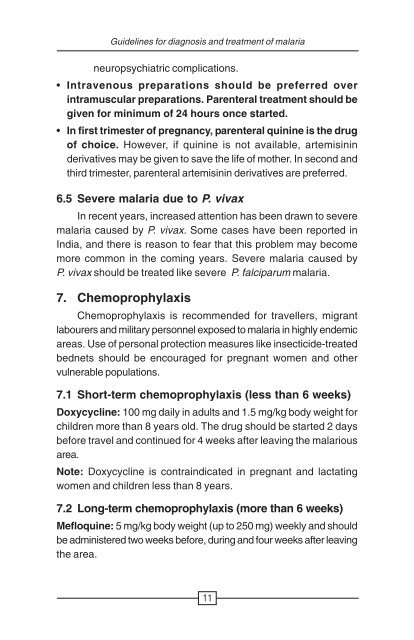Guidelines for Diagnosis & Treatment of Malaria in India - NVBDCP
Guidelines for Diagnosis & Treatment of Malaria in India - NVBDCP
Guidelines for Diagnosis & Treatment of Malaria in India - NVBDCP
You also want an ePaper? Increase the reach of your titles
YUMPU automatically turns print PDFs into web optimized ePapers that Google loves.
<strong>Guidel<strong>in</strong>es</strong> <strong>for</strong> diagnosis and treatment <strong>of</strong> malaria<br />
neuropsychiatric complications.<br />
• Intravenous preparations should be preferred over<br />
<strong>in</strong>tramuscular preparations. Parenteral treatment should be<br />
given <strong>for</strong> m<strong>in</strong>imum <strong>of</strong> 24 hours once started.<br />
• In first trimester <strong>of</strong> pregnancy, parenteral qu<strong>in</strong><strong>in</strong>e is the drug<br />
<strong>of</strong> choice. However, if qu<strong>in</strong><strong>in</strong>e is not available, artemis<strong>in</strong><strong>in</strong><br />
derivatives may be given to save the life <strong>of</strong> mother. In second and<br />
third trimester, parenteral artemis<strong>in</strong><strong>in</strong> derivatives are preferred.<br />
6.5 Severe malaria due to P. vivax<br />
In recent years, <strong>in</strong>creased attention has been drawn to severe<br />
malaria caused by P. vivax. Some cases have been reported <strong>in</strong><br />
<strong>India</strong>, and there is reason to fear that this problem may become<br />
more common <strong>in</strong> the com<strong>in</strong>g years. Severe malaria caused by<br />
P. vivax should be treated like severe P. falciparum malaria.<br />
7. Chemoprophylaxis<br />
Chemoprophylaxis is recommended <strong>for</strong> travellers, migrant<br />
labourers and military personnel exposed to malaria <strong>in</strong> highly endemic<br />
areas. Use <strong>of</strong> personal protection measures like <strong>in</strong>secticide-treated<br />
bednets should be encouraged <strong>for</strong> pregnant women and other<br />
vulnerable populations.<br />
7.1 Short-term chemoprophylaxis (less than 6 weeks)<br />
Doxycycl<strong>in</strong>e: 100 mg daily <strong>in</strong> adults and 1.5 mg/kg body weight <strong>for</strong><br />
children more than 8 years old. The drug should be started 2 days<br />
be<strong>for</strong>e travel and cont<strong>in</strong>ued <strong>for</strong> 4 weeks after leav<strong>in</strong>g the malarious<br />
area.<br />
Note: Doxycycl<strong>in</strong>e is contra<strong>in</strong>dicated <strong>in</strong> pregnant and lactat<strong>in</strong>g<br />
women and children less than 8 years.<br />
7.2 Long-term chemoprophylaxis (more than 6 weeks)<br />
Mefloqu<strong>in</strong>e: 5 mg/kg body weight (up to 250 mg) weekly and should<br />
be adm<strong>in</strong>istered two weeks be<strong>for</strong>e, dur<strong>in</strong>g and four weeks after leav<strong>in</strong>g<br />
the area.<br />
11

















